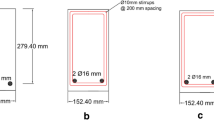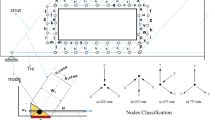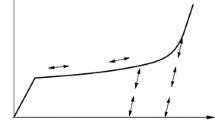Abstract
Due to the brittle nature of shear failure, shear capacity is considered to be one of the most critical and relevant issues in the design of concrete structures. In this research, the possibility of using a discrete lattice model to predict the shear capacity of reinforced concrete beams is investigated. Beams without shear reinforcement and with different beam geometry and varying reinforcement ratios were studied and fracture behaviour from the simulations is compared to experimental results.
Improving (shear) models is important to assess the remaining capacity of existing structures, but also to help design of strengthening solutions for structures with insufficient capacity. In this respect, numerous innovative concrete types have been developed offering possibilities to improve the flexural or shear capacity of concrete structures. Strain Hardening Cementitious Composite (SHCC) and Ultra High Performance Concrete (UHPC), obtained by implementing fibres in the cement based matrix, are such materials. Due to fibre addition and special micromechanical design, especially the ductility, but also the strength, of these materials is significantly improved compared to regular concrete. As a result, structural behaviour of reinforced SHCC and UHPC differs from that of regular concrete. In this research it is further investigated by lattice model analyses. Once the shear behaviour of conventional reinforced concrete and reinforced SHCC (or UHPC) can be reliably simulated, the lattice model might possibly also be suitable to investigate the capacity of concrete structures retrofitted by a layer of SHCC (or UHPC).
Access provided by CONRICYT-eBooks. Download conference paper PDF
Similar content being viewed by others
Keywords
1 Introduction
Shear behaviour has been considered as an important failure mechanism for reinforced concrete structures with or without shear reinforcement. Various analytical models have been developed to predict the shear capacity of structural concrete members (ASCE-ACI Committee 445 1998). Beside analytical models, numerical simulations are considered as a more advanced approach to give more accurate predictions. Such expectation is also implemented in the Model code 2010 as the level IV approximation.
Most numerical approaches on modelling of shear failure focused on using continuum models. Possibly discrete type model, a lattice model, can be a suitable tool for modelling shear. Important in such a model are the simplicity of the model, the number of input parameters and possibility that these parameters can be investigated and verified in independent tests. If robust enough, the model can be used both to predict the capacity of existing structures, but also to further investigate the structural behaviour of innovative concrete types (e.g. reinforced and prestressed SHCC and UHPC). The aim of this paper is to investigate the possibility of using a relatively simple 3D lattice model for predicting shear capacity of reinforced concrete and SHCC beams without shear reinforcement.
2 Modeling Approach
Lattice models have been widely used to simulate fracture, moisture transport, and chloride diffusion in concrete (Schlangen 1993). While widely used in material research, there is only a recent interest in using lattice models for structural analysis (Nagai, Hayashi et al. 2014, Pan, Prado et al. 2017).
The principle of lattice modelling consists of discretizing concrete as a set of truss or beam elements that transfer forces. Elements in the lattice mesh usually have linear elastic behaviour. In each loading step, the element that exceeds the predefined limit stress in the mesh, is removed. The analysis procedure is then repeated until failure is achieved.
The procedure to generate the 3D lattice mesh and ascribe appropriate material properties to the elements of the mesh is as follows:
-
A cubical grid, with a grid linear dimension of 20 mm, is made (for simplicity, only a 2D representation is given in Fig. 1). In each cube a random location for a lattice node is generated. These nodes are called “concrete nodes”.
-
4 closest “concrete nodes” are connected by “concrete beams” using Delaunay triangulation. This leads to that, on average, each node has 14 beams per node in 3D lattice meshes (6 beams in 2D lattice meshes, as presented in Fig. 1). Each node has 6 degrees of freedom (3 translations and 3 rotations).
-
“Concrete beams” are ascribed material properties according to Table 1 and are assumed to have linear elastic behaviour before failure. The tensile strength of lattice elements representing “concrete beams”, as stated in Table 1, is deduced based on the mean tensile splitting strength on 150 mm cubes. Compressive strengths, as used in Table 1, is the mean compressive strength on 150 mm cubes.
Table 1. Parameters used as input in the lattice simulations. -
“Reinforcement elements” are added in a lattice mesh as separate beams and are ascribed corresponding properties (Table 1). Reinforcement is simulated to have ideally linear elastic-plastic behaviour, failing at the strain of 4%.
-
“Reinforcement nodes” are generated at each location where the reinforcement crosses the cubical grid.
-
Concrete – reinforcement (“interface”) beams are generated between the “reinforcement nodes” and the “concrete nodes”. The end nodes of reinforcement are also connected to the concrete node in the cell where the reinforcement end is located. In order to enable more ductility and represent more realistically the pull-out behaviour of the rebar, these interface elements are also assumed to have ideally linear elastic-plastic behaviour (Luković, Dong et al. 2014). This means that the element is not immediately removed from the mesh upon reaching its strength, but its stiffness gradually decreases over a number of analysis steps (Fig. 2). This relation is chosen arbitrarily and it should be further investigated.
-
Lattice elements can fail either in tension or in compression. For the fracture criterion, only normal forces are considered to determine the stress in the beams.
3 Test Setup and Investigated Parameters
Experimental results (Yang 2014) are used for the verification of the lattice model (Fig. 3). Note that from the whole experimental campaign, only experiments with simply supported beams loaded with a single point load (P 2 = 0) were chosen. In order to reduce the computational time, only a part of the full scale specimens was simulated. A beam 3040·500·300 mm3 was modelled in such a way that the critical shear span (shaded blue area in Fig. 3) is simulated properly. The secondary effect that was caused by the different crack pattern at the other span is neglected. Note that with this adjustment the experimentally measured and simulated deflection could not directly be compared. In both cases the deflection is measured under the applied force and because the span of the simulated specimen is smaller than that in the experiment, also the deformation is smaller. However, the shear capacity and type of the failure of the beams were not affected and investigating these phenomena was the main aim of this study.
Experimental test set-up (Yang 2014) and test set-up used for simulation with intention to have similar loading situation of the blue shaded area.
The beams are reinforced with three reinforcement bars, at the top and at the bottom. The influence of following parameters on the modelled shear capacity is investigated:
-
ratio a/d, where a is centre to centre distance between a loading point and the first support of a beam next to it, and d is the effective height of a beam cross section (defined as the distance from the centroid of the tensile reinforcement to the edge fibre of the cross-section in the compressive zone). Three ratios were investigated: a/d = 2, a/d = 2.6 and a/d = 3.3. Depending on the a/d ratio the length of the beam in the simulation is adjusted.
-
area of longitudinal reinforcement: diameter of longitudinal rebar Ø20 mm and Ø32 mm are simulated.
-
type of material: concrete and SHCC.
4 Simulations for Regular Concrete
First, the specimen with dimension of 3040·500·300 mm3 and 3 reinforcement bars of Ø20 mm (both in top and bottom part of the beam) is simulated. Damage propagation and corresponding load deflection diagram are given in Fig. 4. The red lines represent the linear analyses of the lattice model. At the end points of these red lines, one element (either concrete, interface or steel) reaches its strength and is removed. Subsequently, a new linear elastic analysis is performed. In fact only the right end point represent a realistic point in the load-deflection relation for the beam. The characteristic zig-zag pattern (red curve) can be overcome by applying smoothening techniques (black curve). Below the load-defection diagram, the number of broken elements that correspond to each loading stage is given. Only for the main peaks, i.e. when many elements broke, the fracture pattern is shown.
The final deformed shape of the specimen (just after reaching the peak load) is given in Fig. 5a, left. Although in the simulation further analysis can be performed, this is not realistic. The specimen failed before yielding of the rebars occurred. The magnitude of stresses in the rebar prior to failure is indicated in the same figure. In the experiments as well, the rebar did not yield and the specimen lost its capacity because of the opening of the flexural shear crack. This type of failure was denoted as ‘flexure shear failure’ (Fig. 5a, right).
Damage pattern and failure mode in simulation (left) and experiments (right; (Yang 2014)) obtained for (a) a/d = 3.3, (b) a/d = 2.6 and (c) a/d = 2.0.
4.1 Influence of a/d Ratio
Simulations were performed for different a/d ratios and the simulated damage and final failure mode were compared with the experimentally obtained results (Fig. 5b and c). Whereas with a/d ratio of 3.3 flexure shear failure was obtained in simulations (without yielding of the rebars), for a/d of 2.6 and 2.0 the rebars yielded and resulted in flexure failure of the beam.
In experiments, for a/d ratios of 2.6 and 2.0 flexure shear and flexure failure were obtained, respectively. The reason that, for a/d ratio of 2.6 the failure in simulation and experiment differs might be because of the yielding stress that was used for steel. In simulation, the value of 500 MPa was used, while in reality, mean yielding stress of the steel is 550 MPa. As a result, in simulation steel did yielded (reached 500 MPa) and flexure failure was obtained while in experiments the steel did not yield (did not reach 550 MPa) and the beam failed in flexure shear. Furthermore, this might indicate that the tested beam is at the transition point between flexure shear and flexure failure, and small deviations in material properties might affect and change the failure mode.
The load defection curves are plotted and compared in Fig. 6. As indicated before, the deflections cannot be compared directly, but the maximum load can. It is found that the difference in maximum load (shear force) between the simulated beams and those in the experiments is less than 5% (Fig. 6). Both the shear capacity and type of failure seems to be reliably predicted. Note that simulated load displacement curve for flexure failure is too brittle and this might be due to the way that the steel bar is simulated. Namely, after reaching the strain of 4% elements representing steel bar are removed which does not fully correspond with reality. The influence of different material laws for the steel bar on simulated results should be more thoroughly investigated in future.
Damage pattern and failure mode in simulation (left) and experiments (right; (Yang 2014)) obtained for a/d = 3.3, a/d = 2.6 and a/d = 2.0.
In order to investigate the robustness of the model and influence of randomness of lattice mesh, two simulations were performed for the beam with a/d = 2.6. In both cases a similar shear capacity is obtained.
4.2 Influence of Longitudinal Reinforcement
In order to further test the lattice model, the influence of the longitudinal reinforcement ratio on the shear capacity is also investigated. All the other input parameters are kept equal to those in the previous analyses.
A higher percentage of longitudinal reinforcement (1.79%, instead of 0.69% in the previous analyses) is applied, representing rebars of Ø32 mm. The results for maximum load are shown in Fig. 7 together with those for 0.68% reinforcement. As can be see, for the 1.79% percentage of reinforcement and a/d ratios of 2.0 and 2.6 the deviation between simulated and tested capacity of beams is relatively high, as compared to those for 0.68%. The failure pattern obtained in the simulations is shown in Fig. 8, while the type of failure in the experiments, as denoted by Yang (2014) is also given. In both the experiments and simulations shear failure occurred. For the simulations it appeared difficult to distinguish between flexural shear failure and shear compression failure as in (Yang 2014). The failure pattern found in the simulations for a/d = 2.0 showed remarkable good similarity with that observed in the experiment (Fig. 9, (Yang 2014)).
Type of failure observed with 1.79% of longitudinal reinforcement: (a) a/d = 3.3, (b) a/d = 2.6 and (c) a/d = 2.0 (failure mode in experiments (Yang 2014) is given above the plots).
Comparison of failure pattern in experiments (Yang 2014) and simulation for beam with 1.79% longitudinal reinforcement and a/d = 2.0.
5 Simulations for SHCC
Since the simulations of shear failure in regular concrete with the lattice model looks promising, some preliminary analyses for beams with SHCC have been performed. Experimental results for SHCC (Strain Hardening Cementitious Composite) are as yet hard to find in literature. Xu, Hou et al. (2012) reported for SHCC an increase in shear capacity as compared to regular concrete. The shear strength was almost doubled for a/d of 3.0 and 4.0.
For the analysis of the shear behaviour of SHCC, the beam reinforced with 0.69% longitudinal reinforcement and a/d = 3.3 is simulated. Instead of the linear elastic material law, as used for lattice elements that represent concrete, SHCC elements are simulated as ideally plastic with a maximum strain capacity of 5%. The tensile strength of concrete and SHCC is assumed to be the same.
The result for the regular and the SHCC beam is shown in Fig. 10. As can be expected for the significantly different tensile behaviour (strain hardening vs. strain softening), the shear behaviour of the SHCC beam is also significantly different from that of the regular concrete. The shear capacity is almost twice as high and instead of shear failure as found for the regular concrete, bending failure was the failure mechanism. Furthermore, SHCC shows more brittle behaviour and fails at smaller deflection compared to the regular concrete beam.
6 Conclusions
With the intention to investigate the possibilities of the lattice model to simulate shear failure, results for reinforced concrete beams are presented. Furthermore, results of a preliminary analysis of a SHCC beam are shown. Based on the presented results, the following conclusions can be made:
-
The lattice model is able to give very stable prediction on the shear behaviour and the crack pattern of the experiments with very limited material properties.
-
Increased shear capacity of SHCC as compared to regular concrete was confirmed by the analysis.
The obtained results with the lattice model are such that it is considered worthwhile to further explore the possibilities to use it for structural analyses as support in investigating fracture mechanisms of regular and new types of concrete.
References
ASCE-ACI Committee 445: Recent approaches to shear design of structural concrete. J. Struct. Eng. 124, 1375–1417 (1998)
Luković, M., Dong, H., Šavija, B., Schlangen, E., Ye, G., Breugel, K.V.: Tailoring strain-hardening cementitious composite repair systems through numerical experimentation. Cem. Concr. Compos. 53, 200–213 (2014)
Nagai, K., Hayashi, D., Eddy, L.: Numerical simulation of failure of anchorage with shifted mechanical anchorage bars by 3D discrete model. Adv. Struct. Eng. 17(6), 861–869 (2014)
Pan, Y., Prado, A., Porras, R., Hafez, O.M., Bolander, J.E.: Lattice modeling of early-age behavior of structural concrete. Materials 10(3), 231 (2017)
Schlangen, E.: Experimental and numerical analysis of fracture processes in concrete, Ph.D. thesis, Delft University of Technology, Delft, The Netherlands (1993)
Xu, S., Hou, L.-J., Zhang, X.-F.: Shear behavior of reinforced ultrahigh toughness cementitious composite beams without transverse reinforcement. J. Mater. Civ. Eng. 24(10), 1283–1294 (2012)
Yang, Y.: Shear Behaviour of Reinforced Concrete Members without Shear Reinforcement: A New Look at an Old Problem (2014)
Author information
Authors and Affiliations
Corresponding author
Editor information
Editors and Affiliations
Rights and permissions
Copyright information
© 2018 Springer International Publishing AG
About this paper
Cite this paper
Lukovic, M., Yang, Y., Schlangen, E., Hordijk, D. (2018). On the Potential of Lattice Type Model for Predicting Shear Capacity of Reinforced Concrete and SHCC Structures. In: Hordijk, D., Luković, M. (eds) High Tech Concrete: Where Technology and Engineering Meet. Springer, Cham. https://doi.org/10.1007/978-3-319-59471-2_94
Download citation
DOI: https://doi.org/10.1007/978-3-319-59471-2_94
Published:
Publisher Name: Springer, Cham
Print ISBN: 978-3-319-59470-5
Online ISBN: 978-3-319-59471-2
eBook Packages: EngineeringEngineering (R0)














